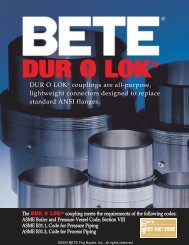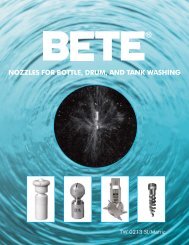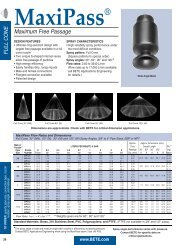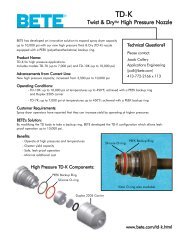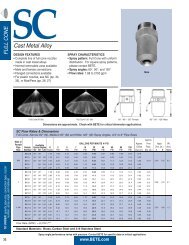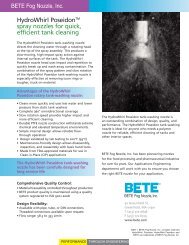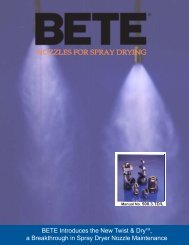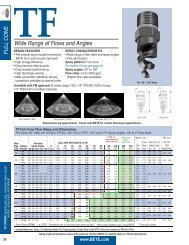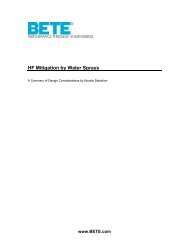Spray Gas Quench Design Considerations - BETE Fog Nozzle, Inc.
Spray Gas Quench Design Considerations - BETE Fog Nozzle, Inc.
Spray Gas Quench Design Considerations - BETE Fog Nozzle, Inc.
- No tags were found...
You also want an ePaper? Increase the reach of your titles
YUMPU automatically turns print PDFs into web optimized ePapers that Google loves.
<strong>Spray</strong> <strong>Nozzle</strong>sBecause of the wide variety ofquench system sizes, configurations,and process requirements,there is no one best nozzle for allapplications. Our design andapplication experience results inthe optimal spray nozzle choicefor your system. We assess yourneeds by determining the categoryof nozzle (single-fluid ortwo-fluid), the specific nozzle model,nozzle size, and material of construction.The range of operation from minimumcapacity to design rate to amaximum rate is also consideredin the nozzle selection. The sprayangle and the arrangement ofmultiple nozzles are also designfactors. Drop size, a critical designfactor; is affected by pressuredrop, spray angle, and nozzleorifice size as indicated inFigure 6. <strong>Inc</strong>reasing the orificesize to accommodate additional flowcan be offset with a higher-pressuredrop or a larger spray angle.Figure 6. Factors affectingdrop size.Table 1 shows specific nozzle modelsand types used in gas quench systems.Wet-wall quench designs often use singlefluidnozzles because of their simplicityand low cost. Wall washing flat fannozzles are used to control the wet-drywall interface to assure solids do notaccumulate on the wall. Dry wall systemsrequire a nozzle selection that provides amore finely atomized spray. Two-fluidnozzles are used in applications requiringa wide range of operation or when a shortevaporation time is required.<strong>Nozzle</strong> Type<strong>BETE</strong><strong>Nozzle</strong>s<strong>Quench</strong><strong>Design</strong>Table 1. <strong>Nozzle</strong> types used for quenching.<strong>Nozzle</strong> BenefitsSingle-fluid flat fan FF, SPN Wet-wall Fan pattern conformswell to wall wetting, highvelocity assures solids do notaccumulate on the wallSingle-fluid Single-fluid Wet-wall or Fine atomization, simplifiedcontrol dry-wallTwo-fluid XA, SpiralAir Dry-wall Wide operating range, finestatomization for short residencetimes, variety of spray angles.The <strong>BETE</strong> SpiralAir nozzle provideshighly efficient use of the atomizing airwith a multistage atomization process andcontrol of the spray pattern by the outletpassages design. Figure 7 shows examplesof different spray patterns that can beused to optimize the spray dependent ongas velocity, residence time, and quenchchamber dimensions.Figure 7. Spiral Air TM spray patternsgenerated by various nozzles caps.<strong>BETE</strong> offers spray nozzle lance assembliesfor single-fluid or two-fluid nozzles tomeet process and materials requirements.Many of applications have specializedmaterials of construction needs to avoidcorrosion and erosion caused by thequench liquid or the process gas. Ourdesign and fabrication capabilitiesprovide the broadest range of alloysfor the nozzle and lance to meet yourspecific needs. We have fabricatedquench nozzle lances from manydifferent materials, such as stainlesssteel alloys, chrome alloys, nickel alloys,cobalt alloys, titanium, and duplexstainless steel alloys.Figure 8. Lateral header withtwo-fluid nozzles.5PERFORMANCE THROUGH ENGINEERING



